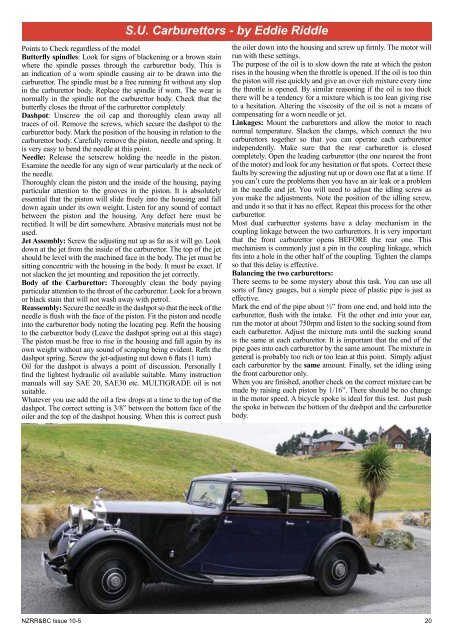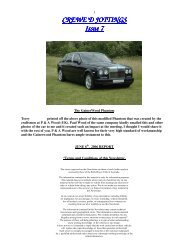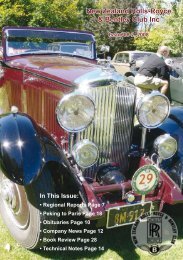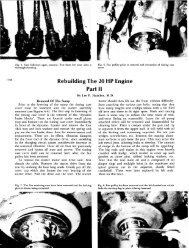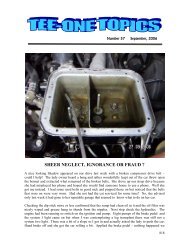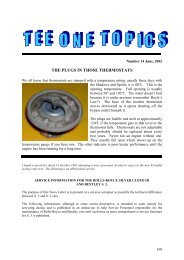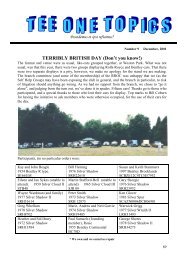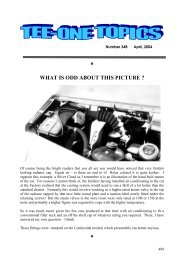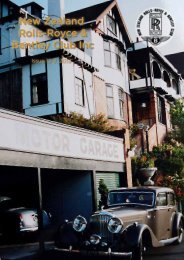New Zealand Rolls-Royce & Bentley Club Inc - KDA132
New Zealand Rolls-Royce & Bentley Club Inc - KDA132
New Zealand Rolls-Royce & Bentley Club Inc - KDA132
You also want an ePaper? Increase the reach of your titles
YUMPU automatically turns print PDFs into web optimized ePapers that Google loves.
Points to Check regardless of the model<br />
Butterfly spindles: Look for signs of blackening or a brown stain<br />
where the spindle passes through the carburettor body. This is<br />
an indication of a worn spindle causing air to be drawn into the<br />
carburettor. The spindle must be a free running fit without any slop<br />
in the carburettor body. Replace the spindle if worn. The wear is<br />
normally in the spindle not the carburettor body. Check that the<br />
butterfly closes the throat of the carburettor completely<br />
Dashpot: Unscrew the oil cap and thoroughly clean away all<br />
traces of oil. Remove the screws, which secure the dashpot to the<br />
carburettor body. Mark the position of the housing in relation to the<br />
carburettor body. Carefully remove the piston, needle and spring. It<br />
is very easy to bend the needle at this point.<br />
Needle: Release the setscrew holding the needle in the piston.<br />
Examine the needle for any sign of wear particularly at the neck of<br />
the needle.<br />
Thoroughly clean the piston and the inside of the housing, paying<br />
particular attention to the grooves in the piston. It is absolutely<br />
essential that the piston will slide freely into the housing and fall<br />
down again under its own weight. Listen for any sound of contact<br />
between the piston and the housing. Any defect here must be<br />
rectified. It will be dirt somewhere. Abrasive materials must not be<br />
used.<br />
Jet Assembly: Screw the adjusting nut up as far as it will go. Look<br />
down at the jet from the inside of the carburettor. The top of the jet<br />
should be level with the machined face in the body. The jet must be<br />
sitting concentric with the housing in the body. It must be exact. If<br />
not slacken the jet mounting and reposition the jet correctly.<br />
Body of the Carburettor: Thoroughly clean the body paying<br />
particular attention to the throat of the carburettor. Look for a brown<br />
or black stain that will not wash away with petrol.<br />
Reassembly: Secure the needle in the dashpot so that the neck of the<br />
needle is flush with the face of the piston. Fit the piston and needle<br />
into the carburettor body noting the locating peg. Refit the housing<br />
to the carburettor body (Leave the dashpot spring out at this stage)<br />
The piston must be free to rise in the housing and fall again by its<br />
own weight without any sound of scraping being evident. Refit the<br />
dashpot spring. Screw the jet-adjusting nut down 6 flats (1 turn)<br />
Oil for the dashpot is always a point of discussion. Personally I<br />
find the lightest hydraulic oil available suitable. Many instruction<br />
manuals will say SAE 20, SAE30 etc. MULTIGRADE oil is not<br />
suitable.<br />
Whatever you use add the oil a few drops at a time to the top of the<br />
dashpot. The correct setting is 3/8” between the bottom face of the<br />
oiler and the top of the dashpot housing. When this is correct push<br />
S.U. Carburettors - by Eddie Riddle<br />
the oiler down into the housing and screw up firmly. The motor will<br />
run with these settings.<br />
The purpose of the oil is to slow down the rate at which the piston<br />
rises in the housing when the throttle is opened. If the oil is too thin<br />
the piston will rise quickly and give an over rich mixture every time<br />
the throttle is opened. By similar reasoning if the oil is too thick<br />
there will be a tendency for a mixture which is too lean giving rise<br />
to a hesitation. Altering the viscosity of the oil is not a means of<br />
compensating for a worn needle or jet.<br />
Linkages: Mount the carburettors and allow the motor to reach<br />
normal temperature. Slacken the clamps, which connect the two<br />
carburettors together so that you can operate each carburettor<br />
independently. Make sure that the rear carburettor is closed<br />
completely. Open the leading carburettor (the one nearest the front<br />
of the motor) and look for any hesitation or flat spots. Correct these<br />
faults by screwing the adjusting nut up or down one flat at a time. If<br />
you can’t cure the problems then you have an air leak or a problem<br />
in the needle and jet. You will need to adjust the idling screw as<br />
you make the adjustments. Note the position of the idling screw,<br />
and undo it so that it has no effect. Repeat this process for the other<br />
carburettor.<br />
Most dual carburettor systems have a delay mechanism in the<br />
coupling linkage between the two carburettors. It is very important<br />
that the front carburettor opens BEFORE the rear one. This<br />
mechanism is commonly just a pin in the coupling linkage, which<br />
fits into a hole in the other half of the coupling. Tighten the clamps<br />
so that this delay is effective.<br />
Balancing the two carburettors:<br />
There seems to be some mystery about this task. You can use all<br />
sorts of fancy gauges, but a simple piece of plastic pipe is just as<br />
effective.<br />
Mark the end of the pipe about ½” from one end, and hold into the<br />
carburettor, flush with the intake. Fit the other end into your ear,<br />
run the motor at about 750rpm and listen to the sucking sound from<br />
each carburettor. Adjust the mixture nuts until the sucking sound<br />
is the same at each carburettor. It is important that the end of the<br />
pipe goes into each carburettor by the same amount. The mixture in<br />
general is probably too rich or too lean at this point. Simply adjust<br />
each carburettor by the same amount. Finally, set the idling using<br />
the front carburettor only.<br />
When you are finished, another check on the correct mixture can be<br />
made by raising each piston by 1/16”. There should be no change<br />
in the motor speed. A bicycle spoke is ideal for this test. Just push<br />
the spoke in between the bottom of the dashpot and the carburettor<br />
body.<br />
NZRR&BC Issue 10-5 20


